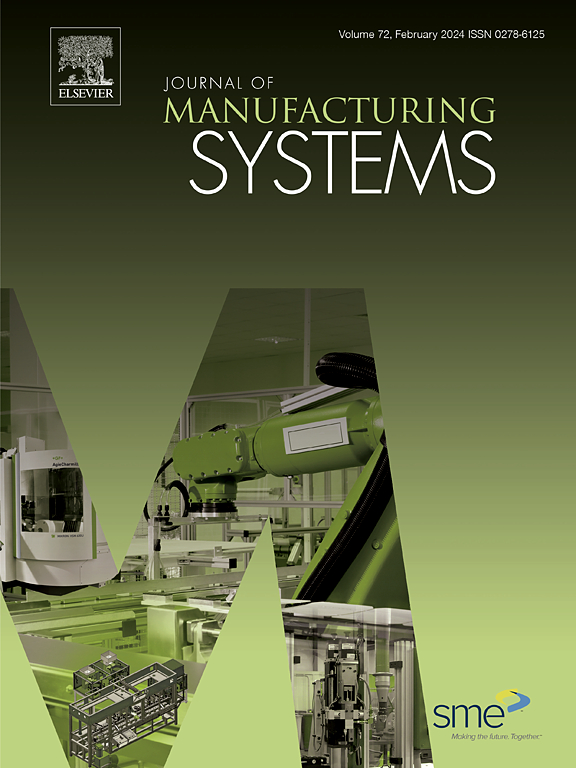Method for drill-bit arrangement in CNC woodworking drilling machine for mass customization
IF 14.2
1区 工程技术
Q1 ENGINEERING, INDUSTRIAL
引用次数: 0
Abstract
In response to the growing demand for personalized products and dynamic changes in the global market, the consumer goods manufacturing industry, particularly the furniture sector, is increasingly adopting the mass customization (MC) production model. In this context, computer numerical control (CNC) woodworking drilling machines play a critical role in enabling flexible MC furniture production, especially during the drilling phase, which often becomes a bottleneck due to lengthy operation times and significant variability. Traditional methods aimed at speeding up equipment operation can no longer improve drilling efficiency. Therefore, optimizing parameter configurations by focusing on the practical usage of the equipment and implementing reconfigurable manufacturing systems (RMS) is essential. This study addresses the bottleneck by proposing an innovative approach to drill-bit arrangement based on the positional relationship between holes, considering real-world scenarios of multi-machine parallel processing and the challenges of quickly and accurately evaluating results. A universal "grouping-solving-evaluation" method is introduced, incorporating clustering, intelligent optimization, and neural networks within artificial intelligence. This method organizes datasets, solves problems, and evaluates results through a deep understanding of CNC machine operations, extensive analysis of large-scale production data, and the creation of a precise mathematical model. The effectiveness of this approach is validated using data from a production site. Our method showed the potential to reduce drilling times by up to 22.99 %, increase efficiency by as much as 17.80 %, and achieve typical improvements of 19.16 % in time reduction and 14.67 % in efficiency compared to traditional manual configurations. These findings provide valuable insights for advancing MC furniture manufacturing and promoting the intelligent production of customized furniture. By enabling the shift from traditional to more personalized and automated manufacturing processes, this research makes a significant contribution to overcoming current production limitations.
大批量定制数控木工钻床的钻头布置方法
为了应对日益增长的个性化产品需求和全球市场的动态变化,消费品制造业,特别是家具行业,越来越多地采用大规模定制(MC)生产模式。在这种情况下,计算机数控(CNC)木工钻孔机在实现柔性MC家具生产方面发挥着关键作用,特别是在钻孔阶段,由于漫长的操作时间和显著的可变性,这往往成为瓶颈。以加快设备作业速度为目的的传统方法已不能提高钻井效率。因此,通过关注设备的实际使用和实现可重构制造系统(RMS)来优化参数配置是必不可少的。考虑到多机器并行处理的现实场景以及快速准确评估结果的挑战,本研究提出了一种基于孔间位置关系的钻头排列创新方法,解决了这一瓶颈问题。介绍了一种通用的“分组-求解-评价”方法,将聚类、智能优化和人工智能中的神经网络相结合。该方法通过对数控机床操作的深入理解、对大规模生产数据的广泛分析以及建立精确的数学模型来组织数据集、解决问题并评估结果。使用生产现场的数据验证了该方法的有效性。我们的方法显示,与传统的手动配置相比,该方法可以将钻井时间减少22.99%,效率提高17.80%,时间减少19.16%,效率提高14.67%。这些发现为推进MC家具制造和促进定制家具的智能化生产提供了有价值的见解。通过实现从传统到更加个性化和自动化的制造过程的转变,本研究为克服当前的生产限制做出了重大贡献。
本文章由计算机程序翻译,如有差异,请以英文原文为准。
求助全文
约1分钟内获得全文
求助全文
来源期刊

Journal of Manufacturing Systems
工程技术-工程:工业
CiteScore
23.30
自引率
13.20%
发文量
216
审稿时长
25 days
期刊介绍:
The Journal of Manufacturing Systems is dedicated to showcasing cutting-edge fundamental and applied research in manufacturing at the systems level. Encompassing products, equipment, people, information, control, and support functions, manufacturing systems play a pivotal role in the economical and competitive development, production, delivery, and total lifecycle of products, meeting market and societal needs.
With a commitment to publishing archival scholarly literature, the journal strives to advance the state of the art in manufacturing systems and foster innovation in crafting efficient, robust, and sustainable manufacturing systems. The focus extends from equipment-level considerations to the broader scope of the extended enterprise. The Journal welcomes research addressing challenges across various scales, including nano, micro, and macro-scale manufacturing, and spanning diverse sectors such as aerospace, automotive, energy, and medical device manufacturing.
 求助内容:
求助内容: 应助结果提醒方式:
应助结果提醒方式:


